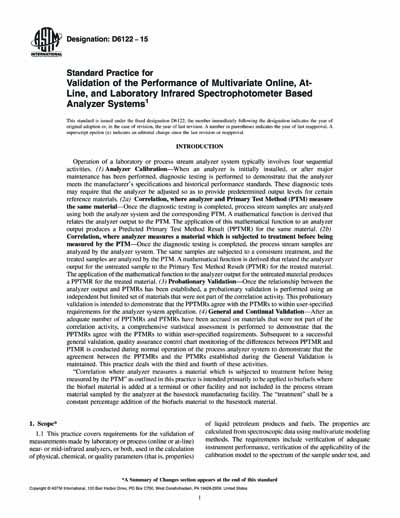Historical
ASTM D6122-15
Standard Practice for Validation of the Performance of Multivariate Online, At-Line, and Laboratory Infrared Spectrophotometer Based Analyzer Systems
1.1 This practice covers requirements for the validation of measurements made by laboratory or process (online or at-line) near- or mid-infrared analyzers, or both, used in the calculation of physical, chemical, or quality parameters (that is, properties) of liquid petroleum products and fuels. The properties are calculated from spectroscopic data using multivariate modeling methods. The requirements include verification of adequate instrument performance, verification of the applicability of the calibration model to the spectrum of the sample under test, and verification that the degree of agreement between the results calculated from the infrared measurements and the results produced by the PTM used for the development of the calibration model meets user-specified requirements. When there is adequate variation in property level, the statistical methodology of Practice D6708 is used to provide general validation of this equivalence over the complete operating range of the analyzer. For cases where there is inadequate property variation, methodology for level specific validation is used.
1.2 Performance Validation is conducted by calculating the precision and bias of the differences between results from the analyzer system (or subsystem) produced by application of the multivariate model, (such results are herein referred to as PPTMRs), versus the PTMRs for the same sample set. Results used in the calculation are for samples that are not used in the development of the multivariate model. The calculated precision and bias are statistically compared to user-specified requirements for the analyzer system application.
1.3 This practice does not cover procedures for establishing the calibration model (correlation) used by the analyzer. Calibration procedures are covered in Practices E1655 and references therein.
1.4 This practice is intended as a review for experienced persons. For novices, this practice will serve as an overview of techniques used to verify instrument performance, to verify model applicability to the spectrum of the sample under test, and to verify equivalence between the parameters calculated from the infrared measurement and the results of the primary test method measurement.
1.5 This practice teaches and recommends appropriate statistical tools, outlier detection methods, for determining whether the spectrum of the sample under test is a member of the population of spectra used for the analyzer calibration. The statistical tools are used to determine if the infrared measurement results in a valid property or parameter estimate.
1.6 The outlier detection methods do not define criteria to determine whether the sample or the instrument is the cause of an outlier measurement. Thus, the operator who is measuring samples on a routine basis will find criteria to determine that a spectral measurement lies outside the calibration, but will not have specific information on the cause of the outlier. This practice does suggest methods by which instrument performance tests can be used to indicate if the outlier methods are responding to changes in the instrument response.
1.7 This practice is not intended as a quantitative performance standard for the comparison of analyzers of different design.
1.8 Although this practice deals primarily with validation of infrared analyzers, the procedures and statistical tests described herein are also applicable to other types of analyzers which employ multivariate models.
1.9 This standard does not purport to address all of the safety concerns, if any, associated with its use. It is the responsibility of the user of this standard to establish appropriate safety and health practices and determine the applicability of regulatory limitations prior to use.
ASTM International [astm]

